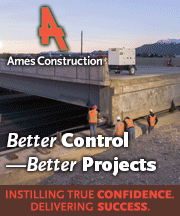
Practicing What We Preach: Hiring Using DBIA Best Practices
by Geoffrey Corey | June 1, 2015
The Design-Build Institute of America (DBIA) is pleased to announce that we have hired Andrew Ausel (pictured), a graduate of Messiah College in Pennsylvania and former Fellow in the Pennsylvania State House, to be our new Manager of Legislative and Public Affairs. Andrew joins us with a passion for legislative affairs, an interest in procurement and project delivery policy, and a belief in the power of team-based working environments. When determining how we would make this hire, we followed hiring best practices that just about everyone uses and realized that they mirror DBIA’s own best practices for design-build procurement.
A DBIA Best Practice that we work to codify into law is the use of two-step design-build selection procedures and limiting the use of one-step, or turnkey design-build. In the one-step process, a request for proposals (RFP) is issued for a project to an unlimited number of participants. All design-build teams are asked to spend time and resources creating detailed proposals immediately. In a two-step process, however, a request for qualifications (RFQ) is issued first, and any team can then respond with a statement of qualifications. The RFQ response is a simple and inexpensive procedure used to create a short list of three to five of the most qualified respondents.
Two-step is preferable because the RFP process is so expensive and time-consuming it makes no sense for a lot of companies to respond when their chance of being chosen is less than 10 percent. So one of the bills DBIA’s new Manager of Legislative & Public Affairs will be working on is H.R. 1666, the Design-Build Efficiency & Jobs Act. This bill would codify that best practice by requiring federal contracting officers to obtain additional approval when short-listing more than five finalists, and also requiring the two-step procedure for any contracts greater than $750,000, thus limiting single-step or turnkey design-build to only smaller projects. This two-step procedure has long been common sense in hiring.
Our job listing asked only for qualifications: a resume, cover letter, and writing samples from previous jobs. This is similar to an RFQ, which often asks for resumes of a firm’s employees, a brief description of interest, and/or examples of past projects. Then, after conducting brief phone interviews (you know, just to make sure the top candidates were real people) we brought in four candidates we thought were most qualified. This is where we began something like the proposal phase; we asked the finalists to complete a writing test before their interview, where they had 24 hours to find examples of three design-build projects relevant to a state senator in the mid-west. They had to submit a one-page document that they thought this senator would find useful and be able to distribute to their colleagues. Then at the in-person interview, we not only discussed each candidate’s qualifications for the job, but how they saw themselves executing the job duties, how they’d handle certain hypothetical situations, and what they thought was enjoyable about the writing test. Oh yeah, and also their greatest weakness (thankfully no one tried to poker-face through “I work too hard”).
It’s important to note that asking four candidates to provide us with this much information was more than enough. During the RFP process, the more full proposals an owner needs to review, the more burdensome that review process becomes. Not only is it much more difficult to make the best decision, it’s a waste of time for those companies who never had a serious chance. I was glad we didn’t ask any of the applicants who were interested in the job despite having minimal qualifications to complete a writing test or come in to interview; it would have been a waste of their time and ours.
Almost everyone agrees that this two-step procedure makes sense in hiring, and we have been very impressed with Andrew’s work for us. Now it’s time the federal government follow the same best practice in choosing a design-builder. We are confident the Design-Build Efficiency & Jobs Act will allow the federal government to more efficiently build quality public projects, and are happy to have Andrew among the many people working on a bill that will help them do just that.






